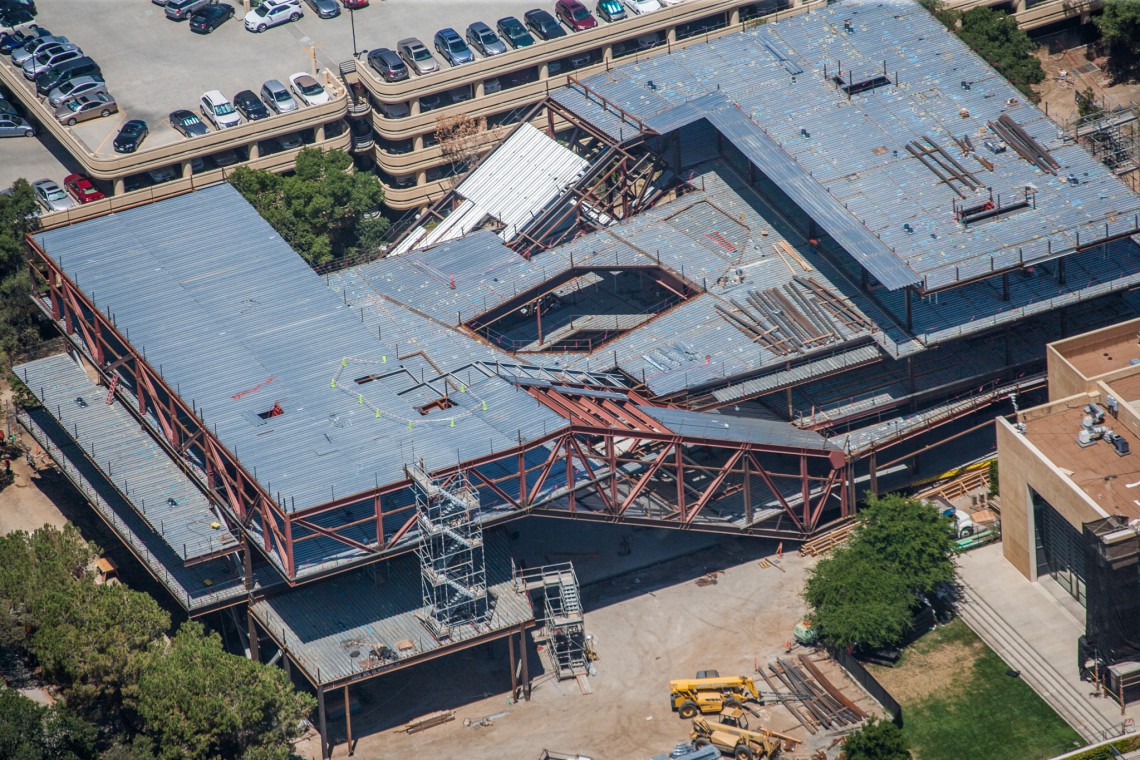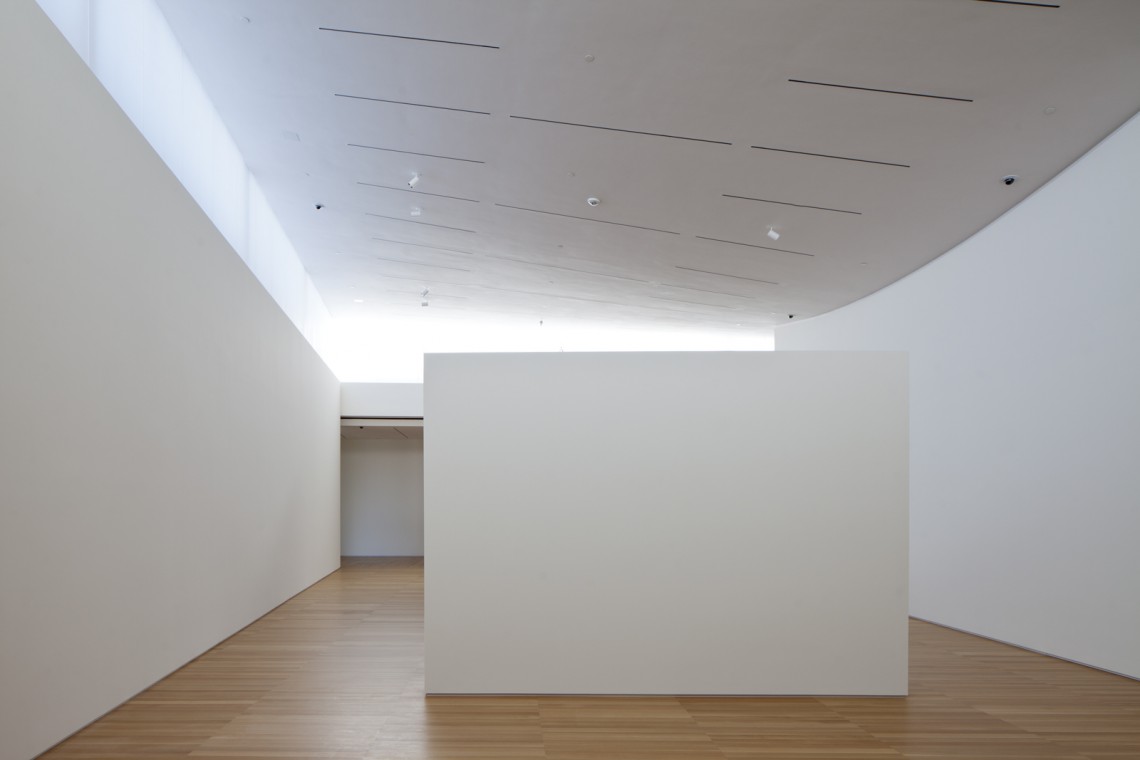-

Courtesy of Land, Buildings & Real Estate
These pictures were taken during a neurosurgery at Stanford's Lucile Packard Children hospital. -

Courtesy of Land, Buildings & Real Estate
Aerial view of the McMurtry Building construction, which is scheduled to be completed in summer 2015. -

Photo © Henrik Kam
Anderson Collection Exterior -

Photo © Henrik Kam
Anderson Collection Staircase -

Photo © Henrik Kam
Anderson Collection Gallery
Stanford’s McMurtry Building is the third new arts building in as many years
Stanford's arts district continues to develop on pace with the completion of the Anderson Collection building and progress on McMurtry. The idea is to build a Stanford arts district that taps into innovative artistic traditions on campus and beyond.
Since hatching the idea of a university arts district in 2007, Stanford has delivered two of three new buildings to join Cantor Arts Center and Frost Amphitheater in a concentration of arts spaces on either side of the Palm Drive entrance to campus.
The Bing Concert Hall has already hosted more than 150 performances since opening to the public in January 2013. Stanford Live is expanding its performance season in the hall this year and introducing social dancing in the spectacular Gunn Atrium.
The Anderson Collection at Stanford University was deemed ready for occupancy by people and art in May of this year. After a summer of careful unpacking and measured hanging, the collection will open to the public on Sept. 21.
Now, the most visible and audible construction project dominating the arts district is the McMurtry Building, the new home to the Art & Art History Department and an interdisciplinary hub for the arts at Stanford. It is on schedule for completion in summer 2015.
McMurtry: history and practice
The design of the McMurtry Building was inspired by Stanford’s campus quad, a hub where students meet, mix and connect. The 96,000-square-foot building, with 24,000 additional square feet of courtyard space, will house courses and classrooms devoted to art study and practice under the same roof.
“While the building was inspired by the traditional arcaded courtyards of Stanford’s historic buildings, its dramatic sculptural presence is unique on campus,” said architect Charles Renfro of Diller Scofidio + Renfro, which designed the project with executive architect Boora Architects. “It is an architecture that both illustrates and contributes to the pedagogical practices of the multiple disciplines housed within.”
To unite the two related but distinct populations of art history and art making, including programs in documentary filmmaking and a joint program in design co-taught with the School of Engineering, the architects envisioned a building comprising two strands that retain distinct identities but embrace and interlock for moments of exchange, promoting discourse and collaboration between the disciplines.
And so, the art historical strand has a stucco exterior, a traditional and recognizable material on Stanford’s campus that embraces the university’s aesthetic and history. The art-making strand is both industrial and contemporary in appearance, with a custom zinc metal finishing.
The art and architecture library, the building’s middle floor, is a “floating” glass box supported by two double cantilevers. The library supports both online and analog research, and there will be dedicated carrel space for doctoral students. At the intersection point between the two strands, where both staircases meet, the library offers views of every floor through the central glass oculus.
Take a virtual architectural tour of the McMurtry Building on the Stanford Arts website.
Engaging the arts
Adjacent to the Cantor, the McMurtry Building is porous and inviting, with a number of entryways to encourage informal engagement with the arts. Every angle of the structure offers a view into art study and practice, and reveals the diverse range of activity that can occur within the space. The entire building promotes transparency – its central oculus and glass studio and classroom walls create encounters with art throughout, while a roll-up glass door feature allows art making and performances to spill outside.
Students’ creativity is immediately showcased to visitors arriving through the formal entrance by a large display wall and adjacent gallery space. On the first floor, a 120-seat flexible presentation space can serve as a classroom with retractable seats, a performance space with acoustical walls or a gallery for presenting work. The space’s glass door can be opened to host outdoor performances, or covered with screens of varying levels of opacity to accommodate projection for lectures as well as creative art purposes.
Other first-floor features are the sculpture studio and a dedicated screening room with raked seating that will be used principally for the documentary filmmaking program.
Though the classrooms and studios are multipurpose spaces with shades and display capabilities, they are individualized by discipline to meet the varied and specific needs of each practice. The building’s abundance of natural light is filtered into studios through a sophisticated frit pattern on the windows to create even light. Clouded glass walls admit light, but also offer privacy to students working within the space.
The faculty offices, located on the third floor, share a ribbon window at desk height that wraps around the building and offers a view into their scholarly process. The offices’ clouded glass doors allow privacy, but also encourage engagement with students passing in the hallway.
The lower level of the building houses photography darkrooms, computer labs and film editing rooms.
Nancy Troy, the chair of the Department of Art & Art History, said, “The art-making studios will have more storage capacity than our facilities in Cummings, enabling us to make better and more efficient use of the new spaces so that we can offer more art practice courses and accommodate more of the demand for such courses among Stanford undergrads.”
Construction mock-ups
Stanford’s Land, Buildings & Real Estate department (LBRE) continues to test prototypes of some of the dynamic design components of the two newest arts district buildings.
University architect David Lenox explains that due to the unique architecture of both the Anderson and McMurtry buildings, the construction mock-ups currently around both sites provide an opportunity to construct mini replicas of the critical components of the buildings and test them out. For example, the mock-ups of the precast panels on the Anderson building had a sculpted, almost crinkled paper texture.
Consistent with LBRE’s commitment to preservation and enhancement of the Stanford campus, projects are underway in the arts district that aren’t just about new buildings. The Cantor is undergoing a facelift to remove stains from the stucco, clean the façade, remove layers of old roof and install a new zinc roof to match the Anderson building zinc systems.
Finally, a path along the edge of Campus Drive between the Anderson Collection and the Bing Concert Hall will be constructed over the summer to improve the arts district connections.
